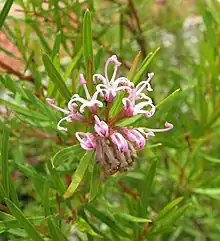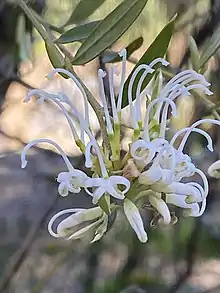Grevillea sericea
Grevillea sericea, commonly known as the pink spider flower,[2] is a species of flowering plant in the family Proteaceae and is endemic to New South Wales. It is a shrub with elliptic to lance-shaped leaves with the narrower end towards the base, and clusters of usually pink flowers arranged on one side of a flowering rachis.
| Grevillea sericea | |
|---|---|
 | |
| Scientific classification | |
| Kingdom: | Plantae |
| Clade: | Tracheophytes |
| Clade: | Angiosperms |
| Clade: | Eudicots |
| Order: | Proteales |
| Family: | Proteaceae |
| Genus: | Grevillea |
| Species: | G. sericea |
| Binomial name | |
| Grevillea sericea | |
| Synonyms[1] | |
| |

.jpg.webp)
Description
Grevillea sericea is a shrub that typically grows to a height of 0.5–2 m (1 ft 8 in – 6 ft 7 in) with angular, ridged, silky-hairy branchlets. The leaves are 25–120 mm (0.98–4.72 in) long and 2–9 mm (0.079–0.354 in) wide, the size and shape depending on subspecies. The flowers are pink, deep purplish pink, rarely white or reddish, and arranged in clusters, more or less on one side of a rachis 15–60 mm (0.59–2.36 in) long, the pistil 14–19 mm (0.55–0.75 in) long. Flowering mainly occurs from August to December, and the fruit is a glabrous, narrowly oval to elliptic follicle 9–16 mm (0.35–0.63 in) long.[2][3][4]
Taxonomy
This species was first formally described in 1794 by James Edward Smith who gave it the name Embothrium sericeum in his book, A Specimen of the Botany of New Holland.[5][6] In 1810, Robert Brown transferred it into Grevillea as G. sericea in Transactions of the Linnean Society of London.[7]
In 1994, Peter M. Olde and Neil R. Marriott described two subspecies of G. sericea in The Grevillea Book, and the names are accepted by the Australian Plant Census:
- Grevillea sericea subsp. riparia (R.Br.) Olde & Marriott[8] has linear leaves 60–120 mm (2.4–4.7 in) long, 1–3 mm (0.039–0.118 in) wide, and purplish pink flowers usually amongst the leaves.[9][10]
- Grevillea sericea (Sm.) R.Br. subsp. sericea[11] has egg-shaped leaves with the narrower end towards the base, to elliptic or narrowly elliptic leaves, usually less than 30 mm (1.2 in) long, 3–9 mm (0.12–0.35 in) wide, and deep to pale pink or white flowers usually mostly above the foliage.[12][13]
Distribution and habitat
Pink spider flower is widespread in New South Wales, and grows in woodland and open forest from near Toronto and Wyee south to near Heathcote, and inland to near Mudgee.[3][12][13] Subspecies riparia has a more restricted distribution, growing near permanent streams mainly near the escarpment of the Blue Mountains, along the Grose and Colo Rivers and Glenbrook Creek.[9][10]
References
- "Grevillea sericea". Australian Plant Census. Retrieved 28 January 2023.
- "Grevillea sericea (Sm.) R.Br". New South Wales Flora online. National Herbarium of New South Wales. Retrieved 28 August 2016.
- "Grevillea sericea". Australian Biological Resources Study, Department of Agriculture, Water and the Environment: Canberra. Retrieved 28 January 2023.
- Wrigley, John W.; Fagg, Murray A. (1991). Banksias, waratahs & grevilleas : and all other plants in the Australian Proteaceae family. North Ryde, NSW, Australia: Angus & Robertson. p. 329. ISBN 0207172773.
- "Embothrium sericeum". APNI. Retrieved 28 January 2023.
- Smith, James E. (1794). A Specimen of the Botany of New Holland. London: James Sowerby. pp. 25–27. Retrieved 28 January 2023.
- "Grevillea sericea". APNI. Retrieved 28 January 2023.
- "Grevillea sericea subsp. riparia". Australian Plant Census. Retrieved 28 January 2023.
- Makinson, Robert O. "Grevillea sericea subsp. riparia". Royal Botanic Garden Sydney. Retrieved 28 January 2023.
- "Grevillea sericea subsp. riparia". Australian Biological Resources Study, Department of Agriculture, Water and the Environment: Canberra. Retrieved 28 January 2023.
- "Grevillea sericea subsp. sericea". Australian Plant Census. Retrieved 28 January 2023.
- Makinson, Robert O. "Grevillea sericea subsp. sericea". Royal Botanic Garden Sydney. Retrieved 28 January 2023.
- "Grevillea sericea subsp. sericea". Australian Biological Resources Study, Department of Agriculture, Water and the Environment: Canberra. Retrieved 28 January 2023.